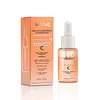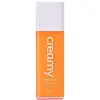What's inside
What's inside
 Key Ingredients
Key Ingredients

 Benefits
Benefits

 Concerns
Concerns

 Ingredients Side-by-side
Ingredients Side-by-side

Water
Skin Conditioning3-O-Ethyl Ascorbic Acid
Skin ConditioningDipropylene Glycol
HumectantGlycerin
HumectantPPG-1-PEG-9 Lauryl Glycol Ether
EmulsifyingSodium Citrate
BufferingCitric Acid
BufferingPhenoxyethanol
PreservativeTocopherol
AntioxidantHydroxyethylcellulose
Emulsion StabilisingDisodium EDTA
Benzyl Alcohol
PerfumingCarnosine
Skin ConditioningParfum
MaskingMaltodextrin
AbsorbentBHT
AntioxidantSodium Acetylated Hyaluronate
HumectantCI 14700
Cosmetic ColorantCI 19140
Cosmetic ColorantCoenochloris Signiensis Extract
Skin ConditioningLecithin
EmollientLycium Barbarum Fruit Extract
AstringentSodium Benzoate
MaskingLactic Acid
BufferingPotassium Sorbate
PreservativeAscorbic Acid
AntioxidantAlpha-Isomethyl Ionone
PerfumingHexyl Cinnamal
PerfumingLimonene
PerfumingLinalool
PerfumingWater, 3-O-Ethyl Ascorbic Acid, Dipropylene Glycol, Glycerin, PPG-1-PEG-9 Lauryl Glycol Ether, Sodium Citrate, Citric Acid, Phenoxyethanol, Tocopherol, Hydroxyethylcellulose, Disodium EDTA, Benzyl Alcohol, Carnosine, Parfum, Maltodextrin, BHT, Sodium Acetylated Hyaluronate, CI 14700, CI 19140, Coenochloris Signiensis Extract, Lecithin, Lycium Barbarum Fruit Extract, Sodium Benzoate, Lactic Acid, Potassium Sorbate, Ascorbic Acid, Alpha-Isomethyl Ionone, Hexyl Cinnamal, Limonene, Linalool
Water
Skin ConditioningAscorbyl Glucoside
AntioxidantDipropylene Glycol
HumectantGlycerin
HumectantEthoxydiglycol
Humectant3-O-Ethyl Ascorbic Acid
Skin ConditioningTocopheryl Acetate
AntioxidantXanthan Gum
EmulsifyingFerulic Acid
AntimicrobialSclerotium Gum
Emulsion StabilisingLecithin
EmollientPhenoxyethanol
PreservativePullulan
Silica
AbrasiveEthylhexylglycerin
Skin ConditioningSodium Hyaluronate
HumectantIngredients Explained
These ingredients are found in both products.
Ingredients higher up in an ingredient list are typically present in a larger amount.
You might know this ingredient as Ethyl Ascorbic Acid, a more stable version of ascorbic acid.
Like other types of vitamin C, this ingredient has many benefits including reducing wrinkles, skin soothing, dark spot fading, and fighting against free radicals.
3-O-Ethyl Ascorbic Acid interferes with the process of skin darkening, helping to reduce hyperpigmentation. It also encourages the skin to produce more collagen.
Once applied, 3-O-Ethyl Ascorbic Acid is converted to Vitamin C deeper in the skin's layers. This process is slow but makes this ingredient more tolerable for skin.
The optimum pH range for this ingredient is 4 - 5.5
Learn more about 3-O-Ethyl Ascorbic AcidDipropylene Glycol is a synthetically created humectant, stabilizer, and solvent.
This ingredient helps:
Dipropylene glycol is technically an alcohol, but it belongs to the glycol family (often considered part of the ‘good’ alcohols). This means it is hydrating and gentle on skin unlike drying solvent alcohols like denatured alcohol.
As a masking agent, Dipropylene Glycol can be used to cover the smell of other ingredients. However, it does not have a scent.
Studies show Dipropylene Glycol is considered safe to use in skincare.
Learn more about Dipropylene GlycolGlycerin is already naturally found in your skin. It helps moisturize and protect your skin.
A study from 2016 found glycerin to be more effective as a humectant than AHAs and hyaluronic acid.
As a humectant, it helps the skin stay hydrated by pulling moisture to your skin. The low molecular weight of glycerin allows it to pull moisture into the deeper layers of your skin.
Hydrated skin improves your skin barrier; Your skin barrier helps protect against irritants and bacteria.
Glycerin has also been found to have antimicrobial and antiviral properties. Due to these properties, glycerin is often used in wound and burn treatments.
In cosmetics, glycerin is usually derived from plants such as soybean or palm. However, it can also be sourced from animals, such as tallow or animal fat.
This ingredient is organic, colorless, odorless, and non-toxic.
Glycerin is the name for this ingredient in American English. British English uses Glycerol/Glycerine.
Learn more about GlycerinLecithin is a term for a group of substances found in the cell membranes of plants, animals, and humans. They are made up of mixture of phospholipids.
This ingredient has emollient and emulsifying properties.
As an emollient, lecithen helps soften the skin and creates a barrier to keep moisture in.
As an emulsifier, it also helps prevent water and oil ingredients from separating. Lecithin can also help ingredients be better absorbed by the skin.
This is because the phospholipids in lecithin produce liposomes. Liposomes help other ingredients get through the skin barrier.
Depending on the source of this ingredient, lecithin may not be fungal acne safe. This is because some sources of lecithin come from soybean oil, which may feed the malassezia yeast that feeds fungal acne.
We recommend reaching out to the brand you are purchasing from to inquire about the source of their lecithin.
Some other names for this ingredient include soy lecithin and deoiled soy lecithin.
Learn more about LecithinPhenoxyethanol is a preservative that has germicide, antimicrobial, and aromatic properties. Studies show that phenoxyethanol can prevent microbial growth. By itself, it has a scent that is similar to that of a rose.
It's often used in formulations along with Caprylyl Glycol to preserve the shelf life of products.
Water. It's the most common cosmetic ingredient of all. You'll usually see it at the top of ingredient lists, meaning that it makes up the largest part of the product.
So why is it so popular? Water most often acts as a solvent - this means that it helps dissolve other ingredients into the formulation.
You'll also recognize water as that liquid we all need to stay alive. If you see this, drink a glass of water. Stay hydrated!
Learn more about Water